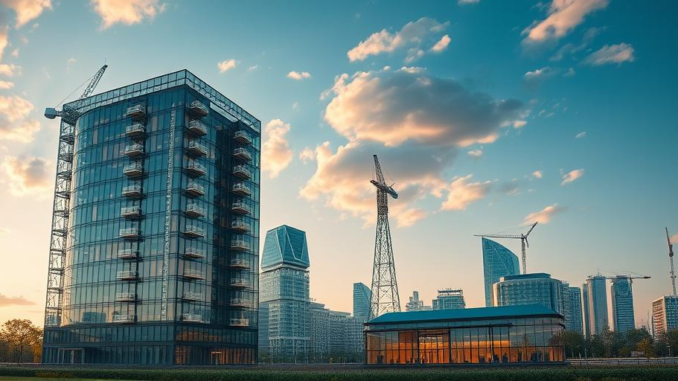
Summary
This article provides eight actionable steps to boost energy efficiency in new buildings. From initial design considerations to implementing smart technologies and promoting sustainable practices, each step contributes to significant energy savings and a smaller environmental footprint. By following these guidelines, builders can create sustainable, cost-effective, and environmentally responsible structures.
Successful low-energy building design hinges on careful planning. Focus360 Energy can help.
** Main Story**
Building Energy-Efficient Structures: An Eight-Step Guide
Creating energy-efficient buildings is no longer a luxury, but a necessity. It’s about shrinking our environmental footprint while also saving money. This eight-step guide provides actionable advice for constructing energy-efficient buildings from the ground up.
- Early Planning and Design:
Integrate energy efficiency from the outset. Consider the building’s orientation to maximize natural light and minimize solar heat gain. Utilize energy modeling software to simulate energy performance and optimize design choices.
- Building Envelope Optimization:
A well-designed building envelope is crucial. Employ high-performance insulation, energy-efficient windows, and airtight construction to minimize heat transfer and air leakage. This creates a comfortable indoor environment and reduces the strain on HVAC systems.
- Efficient HVAC Systems:
Heating, ventilation, and air conditioning (HVAC) systems consume significant energy. Opt for high-efficiency HVAC units with smart thermostats and controls. Implement proper duct sealing and insulation to minimize energy loss. Consider natural ventilation and passive cooling strategies whenever possible.
- Lighting Systems Upgrade:
Transition to LED lighting with smart controls. LEDs offer substantial energy savings, longer lifespans, and improved light quality. Incorporate daylight harvesting systems and occupancy sensors to further optimize lighting usage.
- Smart Technology Integration:
Utilize building automation systems (BAS) to monitor and control energy consumption. BAS can track energy usage in real time, automate lighting and HVAC operations, and identify opportunities for improvement. Integrate renewable energy sources such as solar panels to reduce reliance on the grid.
- Water Efficiency Measures:
Install low-flow fixtures and water-efficient appliances. Implement rainwater harvesting systems for irrigation and non-potable water use. Design landscaping that requires minimal watering.
- Commissioning and Monitoring:
Conduct thorough commissioning to ensure all systems are functioning optimally. Implement ongoing monitoring to track energy performance and identify potential issues. Regular maintenance and system checks are crucial for sustained efficiency.
- Occupant Engagement and Education:
Promote energy-efficient practices among building occupants. Provide training on how to use building systems effectively. Encourage the use of natural light and ventilation. Foster a culture of energy conservation to maximize the building’s efficiency potential.


Step eight about occupant engagement? Genius! Now, how do we train the office plants to conserve energy? Asking for a friend (who may or may not have considered tiny sweaters for the thermostat).
That’s a great point about occupant engagement, and a hilarious image! Perhaps we could start by replacing the plants with cacti (low water consumption!). On a serious note though, clear communication and easy-to-use interfaces are key for successful occupant involvement in energy conservation.
Editor: FocusNews.Uk
Thank you to our Sponsor Focus 360 Energy
Step five mentions smart tech. But, will these buildings become *too* smart? Asking for a friend who fears their toaster is judging their bread choices. What are the safeguards against our buildings developing… opinions?
That’s a hilarious and valid concern! Ensuring data privacy and user control is paramount. Robust cybersecurity measures and transparent algorithms are crucial to prevent those ‘building opinions’ and keep our toasters neutral. Perhaps ethical guidelines for AI in buildings are needed!
Editor: FocusNews.Uk
Thank you to our Sponsor Focus 360 Energy
Regarding early planning and design, what specific incentives or regulations have proven most effective in encouraging developers to prioritize energy efficiency from the outset of a project?
That’s a crucial question! Some areas have found success with density bonuses for energy-efficient designs. Others are using streamlined permitting processes or tax incentives. Regulations like mandatory energy performance targets are also gaining traction. It really depends on the local context and priorities. What incentives do you think would work best in your area?
Editor: FocusNews.Uk
Thank you to our Sponsor Focus 360 Energy
The emphasis on early planning is key. Integrating energy modeling software from the start, as mentioned, allows for informed decisions about building orientation and materials, potentially leading to significant long-term savings.
Thanks for highlighting the importance of early planning! Energy modeling software truly is a game-changer. Do you have any experience with specific programs that you’d recommend for optimizing building design? I’d love to know what’s worked well for you and others.
Editor: FocusNews.Uk
Thank you to our Sponsor Focus 360 Energy